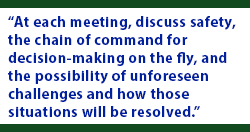
5 times to communicate deliberately
 By Peter Coyne, Vita Plus sales manager
By Peter Coyne, Vita Plus sales manager
As grain prices climb, harvesting exceptional forages will be essential for dairy producers’ profitability in 2021. If there was ever a year to ensure optimal forage harvest, this is the year. Preparing your team to work together, to think as one, to understand the importance of safe and efficient work as they harvest, and to store exceptional feed requires deliberate planning and communication. It is never safe to assume everyone is on the same page.
1. Start with the right team.
Assembling a great team and setting high expectations is a prerequisite to a successful harvest. Having open and deliberate communication across the entire team is essential. A fully engaged staff knows what is expected and they understand how they play a role in the success (or failure) of the team.
2. Discuss the “why.”
It is essential that team members understand why their work is important. Managers, supervisors and foremen should be deliberate in making sure the individuals on the team know why the specific tasks they do are critical to overall harvest success.
3. Every member of your team should know:
- Why feed needs to be harvested at a proper moisture and what that goal is for each crop harvested
- What chop length is and why the chopper is set the way it is
- Why packing density improves forage quality and how they can play a role in improving packing density
- The importance of operating all equipment in a safe manner
- That they can safely offer feedback if they see something unexpected
The fourth of Sam Walton’s “10 Rules for Building a Business” is “communicate everything you possibly can to your partners. The more they know, the more they’ll understand. They more they understand, the more they’ll care. Once they care, there’s no stopping them.”
4. Ensure the right people are at the meeting table and be deliberate in holding meetings at the right time.
Preharvest planning meetings are essential to making great forages. Three meetings typically take place each year:
- Before first-crop hay
- In mid-July after second crop, but well before corn silage
- After corn silage is complete, some density measurements have been taken, some of the feed has been fed, and we know the quality results
Attendees include farm and herd managers, maintenance managers, those people who are in the choppers and pack tractors, and one or two truck drivers along with the nutritionist and possibly the feeder.
 5. Make an agenda and record the decisions you make.
5. Make an agenda and record the decisions you make.
During the first meeting, everything is discussed. This includes expected harvest moisture, field order, chop length, where the feed will be stored, who will make the call on merging, what to do with wet haylage (make a separate pile and feed early), how many pack tractors, and how to position specific trucks for dumping.
The second meeting is an opportunity to discuss what has gone well thus far and what changes were made or need to be made. The second meeting also sets the stage for corn silage harvest and the differences between haylage and corn silage logistics.
At each meeting, discuss safety, the chain of command for decision-making on the fly, and the possibility of unforeseen challenges and how those situations will be resolved.
The final meeting of the year should offer a review of what did and did not go well during harvest and the results (from both a feed quality and personnel standpoint). We also begin planning for next year.
If you have not held a preharvest meeting in the past, consider this a good time to start. We have a template available to assist you and are happy to help in any way we can.
Gallop tells us a highly engaged workforce improves productivity by 20%. Deliberate communication with your team gives them a better understanding of why their work is important and how they can affect the outcome, which improves engagement. A 20% increase in productivity pays big dividends in feed quality, harvest efficiency, decreased down time and farm safety.
| Category: |
Business and economics Employee management Forage Foundations Safety |

